| 113
|
CHAPTER 18
A Low-Cost Stump-Cast Clamp
for Making Artficial Legs
Experimenting with Village-Made Limbs
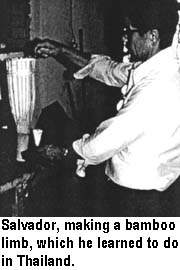
In Mexico, there are thousands of people who need an artificial leg, but
don't have the money to buy one. A modern above-the-knee prosthesis often
costs a farm laborer or factory worker twice his or her yearly wages.
The PROJIMO team has experimented with different kinds of low-cost legs.
They sent a villager to Thailand to be an apprentice for making bamboo
limbs, molded leather sockets, and wooden knee-joints. (All of these are
pictured in the book, Disabled Village Children.) Some of the
"appropriate technology" legs worked very well. But - alas! - most people
did not like them: they said they looked too primitive. They had seen fancy
limbs made of fiberglass, and they wanted something "modern."
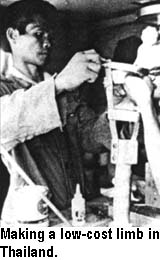
In response to users' wishes, PROJIMO arranged for a team member,
Florentino, to apprentice for two weeks in a limb-making shop in a distant
city. There he learned the basics of making fiberglass-and-resin limbs. When
he returned, Florentino improved his skills by trial and error. He shared
what he knew with Marcelo Acevedo, who in time became a master limb-maker.
Marcelo, in turn, taught Guadalupe (himself an amputee), Conchita (see
Chapter 42), and others.
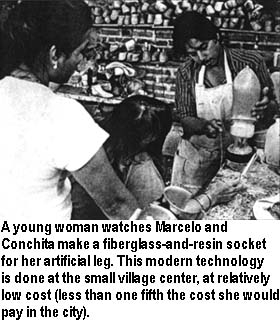
PROJIMO has been able to fit persons with modern fiber-glass legs at a
much lower cost than they could find elsewhere. While quality varies, these
limbs tend to be better than those made at much higher cost by professionals
in the cities. Two government rehabilitation programs have contracted with
PROJIMO to fit their clients with these artificial legs.
The PROJIMO leg-makers (mostly disabled) have had little formal training,
They learn by doing. Although their technical skills may not equal
those of highly trained technicians, it is their relationship with the
persons receiving limbs that makes all the difference. Often the
person stays several days, and becomes involved in fitting and building the
limb. After it is done, she spends the next days at PROJIMO learning how to
walk with it. Efforts are made to fix any problems, even when this means
remaking the leg.
A good limb is the result of a close working relationship between
builder and user. |
| 114
|
LOW-COST MATERIALS AND SECOND-HAND PARTS
Marcelo and the other limb makers at PROJIMO have devised several
techniques for making modern fiberglass-socket limbs at lower cost.
Whenever possible, they try to get high-quality knee-joints from discarded
limbs (often those of elderly persons with diabetes who have died).
Support persons and groups in the USA and elsewhere are on the lookout for
second-hand joints, foot pieces, and other parts. Where such recycling is
possible, top-quality limbs can be provided at affordable prices.
To make a limb that fits well, the first step is to cast the person's
stump. First, the technician makes a "negative" (hollow) cast of the stump
by wrapping a plaster bandage over the stump. Next, the technician makes a
"positive" (solid) mold, by filling the hollow cast with plaster.
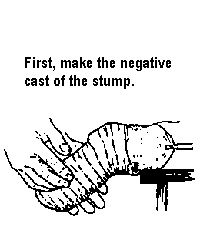
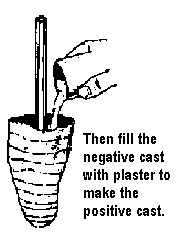
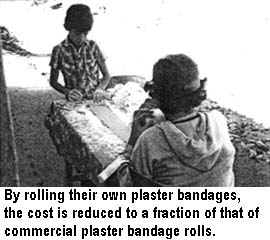
The team has found ways to keep down the costs. First, they have
experimented with roll-your-own plaster bandages, rather
than buying expensive commercial plaster bandages. With these home-made
plaster rolls, casting the stump is somewhat more difficult, but the cost
is only about one tenth that of the commercial equivalent.
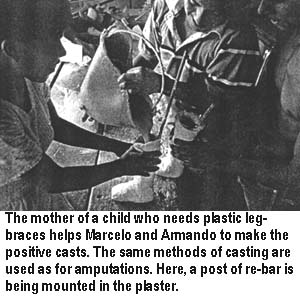
The time it takes for the plaster to set (that is, to
get hard after wetting it with water) can be controlled in 2 ways. To
speed up the setting time, add a small amount of salt (ordinary table
salt) to the unset plaster powder. Or add a little powder from old plaster
that has already set. (The dust that collects from filing plaster molds
works well.) CAUTION: Hot weather or warm water also speeds up the
setting time, so local experimenting is necessary.
For making positive casts, the village leg-makers use low-cost plaster
sold for building houses; instead of costly orthopedic plaster-of-Paris.
Most limb makers, when they make a positive cast, put into it a 1/2
inch metal water-pipe. The pipe is used to grip the heavy stump-cast in a
vise while it is being "modified" (shaped into a form for molding the
socket).
Instead of the metal pipe, PROJIMO uses re-bar
(reinforcing rod, used in the cement walls of buildings). It is cheaper. |
| 115
|
A CLAMP TO HOLD THE STUMP-CAST
Problem: To position and reposition the heavy stump
cast while modifying it to form the mold for the socket of the artificial
limb, a clamp is needed to hold it securely. Most high-class prosthetic
(artificial limb) shops have a strong, factory-made clamp. But this is
expensive (the equivalent of about US $130). For this reason, PROJIMO's
leg-makers simply used a bench-vise to grip the metal rod which they had
molded into the cast.
However, with the force used in filing and shaping the cast, the bar
often slipped in the vise. Also, the cast needed to be rotated repeatedly
during modification. To do this, the vise had to be loosened, and the
heavy cast had to be held in the right position while tightening the vise.
For a big heavy cast this often took two persons.
Solution: One time a North American limb-maker, John
Fago, was visiting PROJIMO to help the team up-grade their skills. John is
an amputee who first came to the project as a photographer. (Several
photos in this book are by John.) After visiting PROJIMO, John decided to
get training as a prosthetist, in order to help in the development of
low-cost, high-quality limbs, (He now runs a small, non-profit program
called New Legs for Nomads.) Marcelo explained to John the
difficulty he had in trying to hold the stump-cast in a bench vise.
Together, Marcelo and John set about designing a simple stump-cast
clamp which would hold the cast securely, yet also allow it to be easily
and quickly repositioned.
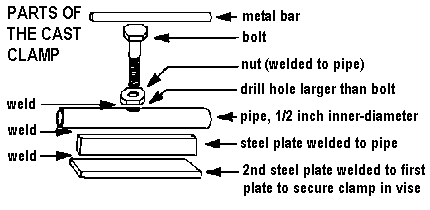

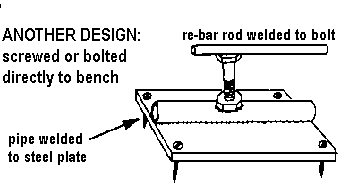
Usefulness elsewhere. The clamp was put together out
of scrap metal in about 1 hour. It works remarkably well, allowing the
cast to be effortlessly rotated and re-clamped.
The innovation proved so popular that Javier, who worked in the brace
shop, took one look at it and immediately made one to hold casts for
making orthopedic appliances.
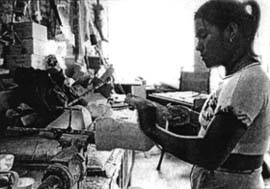
A few months later, John Fago took his photos of the clamp to Cambodia
(where tens of thousands of people have lost their legs from stepping on
land mines - see page 173). Limb-makers in
small shops there faced similar problems and, on seeing the photos, at
once made their own cast clamps - adapting the PROJIMO design to local
materials. So PROJIMO, which had originally taken some of its appropriate
technology ideas from grassroots limb shops in the Far East, was able to
return a useful innovation. |
| 116
|
How Good Ideas Spread
From Mexico ...
John Fago showed photos like these of PROJIMO's stump-cast clamp to
village limb makers in Cambodia.
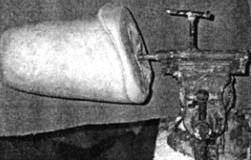
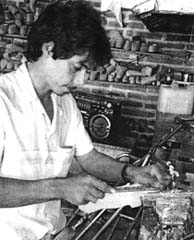
... to Cambodia
When the Cambodian limb-makers (who also had disabilities) saw John's
photos, they realized how much easier it could make their work, and
promptly made their own, as shown here.
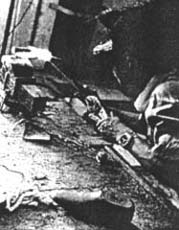
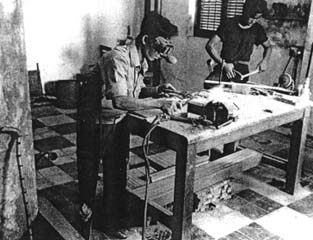
|
| 117
|
The Key to Making Legs is Making Friends
|

|
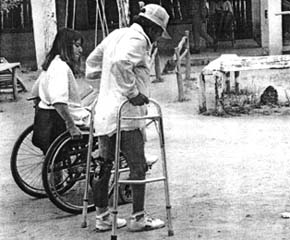
|

|
| Conchita and Marcelo have worked hard
to learn how to make modern fiber-glass-and-resin limbs, because this
is what people say they want. |
Before she finishes a limb, Conchita
makes sure it fits well. Here, a man tests his new leg while Conchita
assists him in learning to walk.* |
Walking is easier with the arms
straighter. |
_________________________________________
*CAUTION: Reviewers of this book have rightly pointed out that
this man's walker is too high (as are the crutches of the smiling boy on
page 273). His elbows are bent far too
much. For easier walking on walkers, crutches, or parallel bars, usually
the arms should be nearly straight (see page 11).
Conchita, of course, could argue that the high walker encourages its user
to bear more weight on his new leg. What do you think? |
| 118
|
|
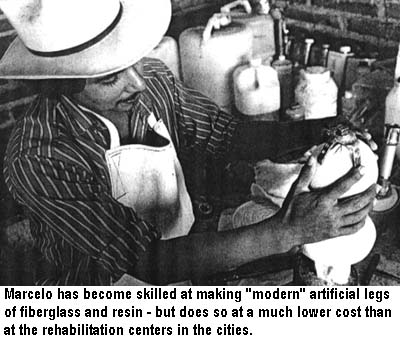 |
|